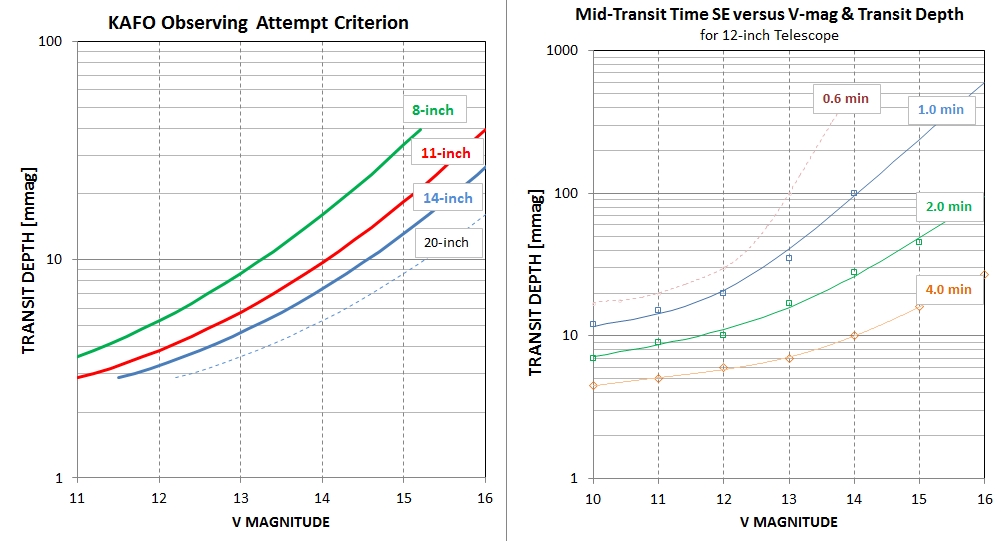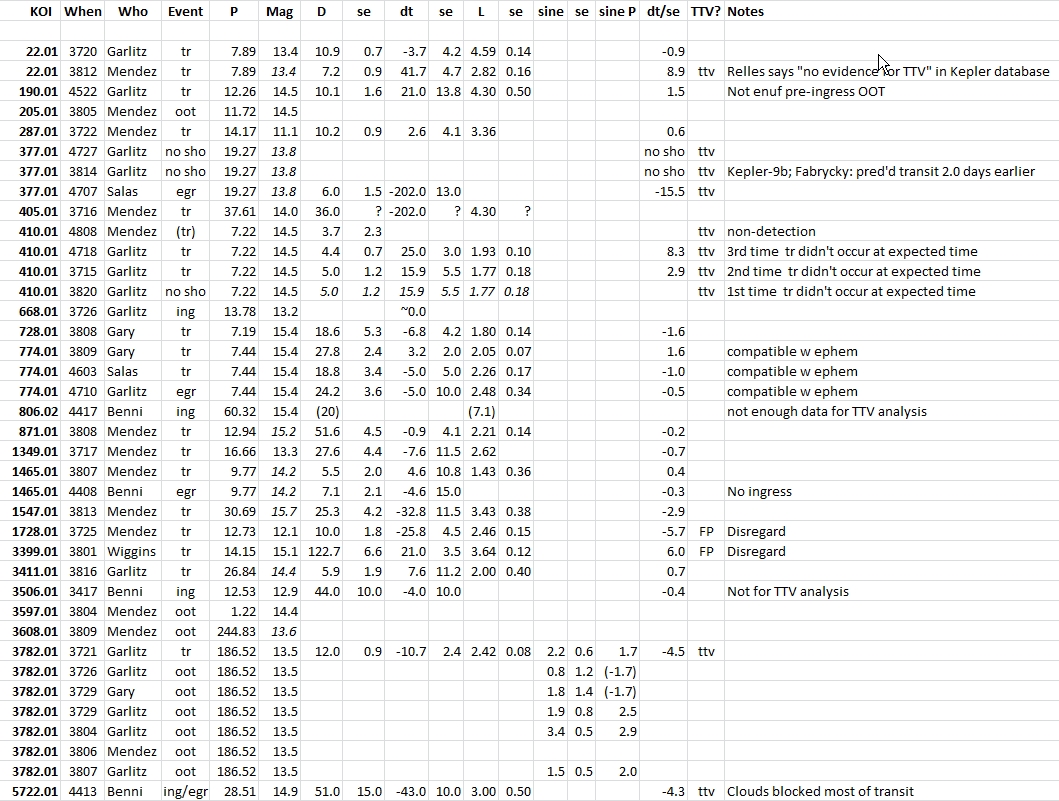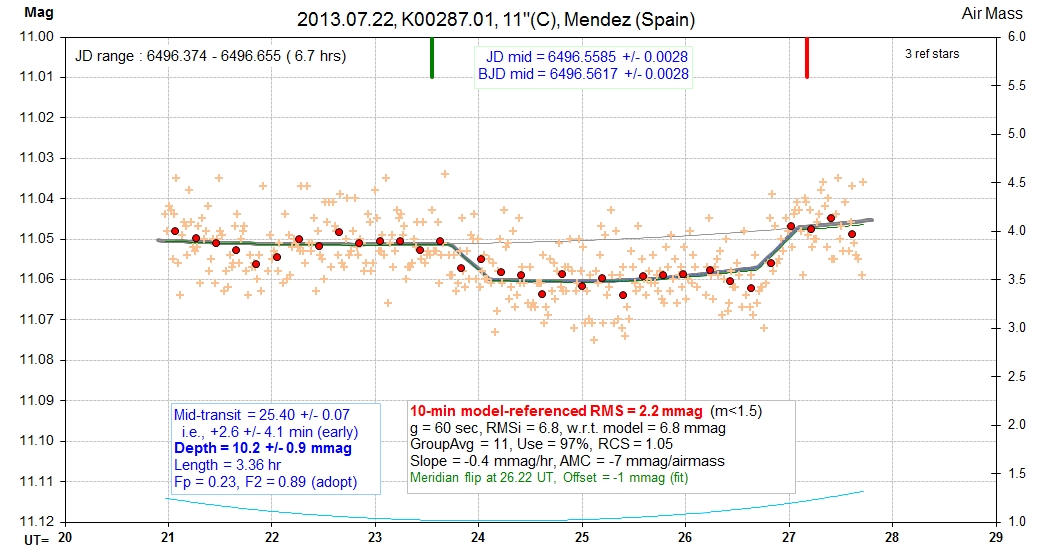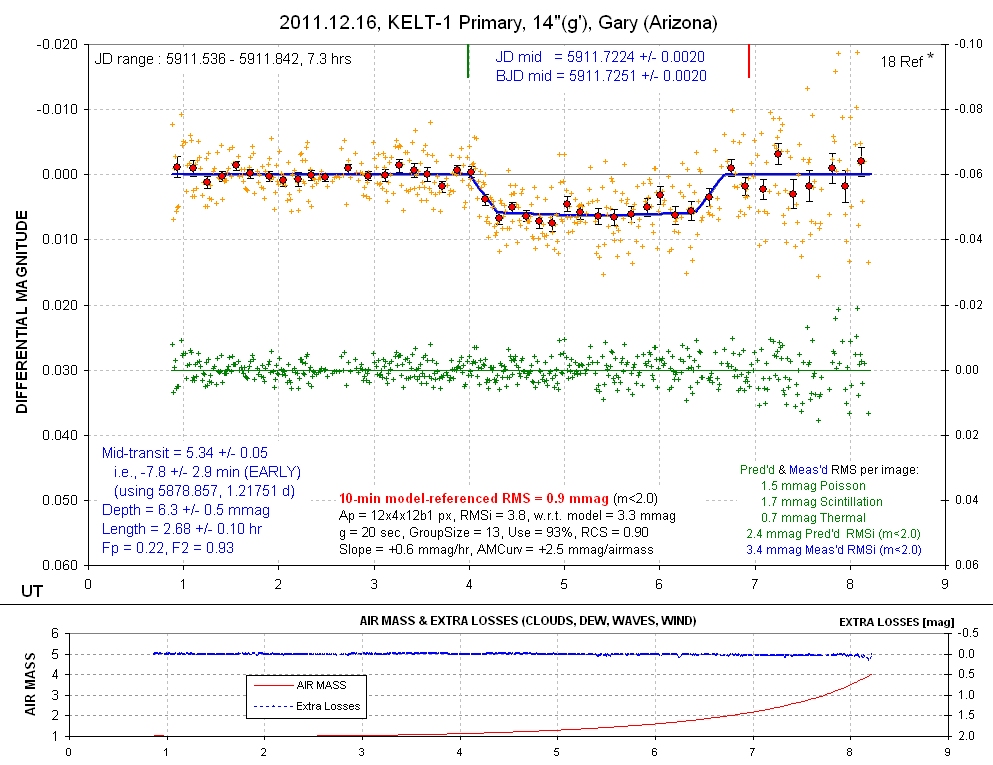This web page is no
longer being supported, due to lack of interest by everyone (myself
included). It once seemed like a good idea. 2015.06.16.
Kepler Amateur Follow-Up Observations
Webmaster: Bruce Gary
This
web site resumed active status after a
suspension (Apr 24 to May 17). I have now
reassessed the feasibility of amateur
observations contributing to refinement
of TTV for Kepler objects. This reassessment
was prompted by an analysis by Howard Relles
in April showing that most KAFO light curves
weren't accurate enough to be useful for that
purpose. After reviewing how KAFO was
structured I found two flaws: 1) Kepler
candidates with absolutely no TTV at high
precision were included in the KAFO active
list, and amateur observations of these
objects with low precision were a "waste of
time," and 2) KAFO observers were not provided
guidance on which Kepler candidates were
realistic for observation, based on magnitude,
transit depth and telescope aperture. The new
KAFO addresses both flaws: 1) only Kepler
objects with known or suspected TTV are
included in the active list, and 2) a graph is
provided that observers can use for assessing
whether an object is both bright enough and
has a deep enough transit depth to be usefully
observed for a specific telescope
aperture.
_______________________________________________________________________________________________
This website lists Kepler exoplanet candidates
with known or suspected TTV that are observable by
amateurs. The Kepler project's latest release now includes
>7280 candidates; 26 of these are either known or
suspected of exhibiting TTV. The "KAFO active list" will
show which oof these 26 objects are predicted to have
transits during a 2-week interval. Observers are encouraged
to select objects for observation based on a graph showing
an empirical relationship between V-mag, transit depth and
telescope aperture. Long period exoplanets are
emphasized because they are in some respects more suitable
for a network of amateur observers than a small number of
professional observers since amateurs are found at a large
range of longitudes and sample a wide range of weather
conditions at any desired observation time. Follow-up
analysis of mid-transit times reported on this web site will
be performed by Sigfried Vanaverbeke (and maybe Howard
Relles), and these results will be included in a section of
this web page when they become available.
Recent Updates:
Oct 29: Added K00377.01 LC by Gary
Oct 28: Updated events list
Currently Active List: (light curves are at
KAFO LCs)


Figure 1 (top). The "Currently Active List" above
includes a column labeled "TTV [min]," kindly provided by
Howard Relles (http://exoplanet-science.com/KAFO.html),
showing the amplitude of TTV variation. A zero entry means
that an insufficient length of Kepler observations is
available for estimating the period and amplitude of TTV
(i.e., period of TTV variability is too long or shape of TTV
is too complicated). The last column ("Aperture Needed") is my
estimate of telescope aperture [inches] needed to observe the
transit with an accuracy useful for KAFO. If the required
aperture exceeds 100 inches (based on my ground-based, typical
performance, given as Fig. 2) then "..." is displayed. Note:
K00377.01 is a special case. It is uncertain by up to 2.5
days, so I've included entries that sample this uncertainty
(K003777.01' is for Fabrycky's solution, K00377.01'' is for
Relles' solution extrapolated.)
Figure 2 Lower-left. Guidance for assessing
feasibility of providing useful timing information for a
transit event based on the star's brightness, the
transit depth and telescope aperture. The area above
the trace is "feasible." For example, a 11-inch telescope
observing a star with V-mag = 14.0 can provide "useable"
transit observations when transit depth > 10 mmag (assuming
sufficient pre-ingress and post-egress data are available, and
the light curve quality is good in other respects).
Figure 2 Lower-right. Empirically-based mid-transit
time SE for a 12-inch telescope versus V-mag & transit
depth (assuming a good quality light curve). For other
telescopes I suggest multiplying transit depth by
(12-inch/aperture) and sliding the traces right or left by
amount = 2.5 * LOG(aperture/12-inch). For example, a 24-inch
telescope observing a V-mag = 12.75 star (0.75 mag right
adjust is for larger aperture) will have a 1.0 min SE when
transit depth ~ 10 mmag. Note: naive modeling of timing SE
doesn't allow for systematic effects that vary greatly with
observer (reference stars used, photometry apertures used,
seeing variability, etc). Actual SE values can be larger by a
factor of 2 or 3 (if light curve quality is poor).
The chart above is based on an analysis of previously submitted
LCs. I plotted quality symbols on the V/D field and found that a
trace could be constructed that separated the useable from
un-useable LCs with nearly 100% accuracy. All of the attempts
below the trace were un-useable (10 out of 10), and 79% of the
LCs above the trace were useable (11 out of 14).
Observers, try to observe the entire night (these are long
period candidates which tend to have long transit lengths). Even
if only an ingress, or egress, is observed, this can be useful.
Combining light curve segments can be achieved if they overlap
(or if same filter and reference stars are used, etc). I
recommend using a clear filter (or better yet, a Cb filter,
clear with blue blocking). Second choice is r'-band filter, or
Rc-band filter. Third choice is V-band. Make sure the PSF has
FWHM > 2.5 or 3.0 pixels (to avoid "pixel edge noise); if you
feel the need to bin 2x2, and if FWHM < 3 pixels, it's
suggested that you defocus to broaden PSF. Keeping the star
field fixed with respect to the pixel field will reduce
systematic effects, such as those related to notoriously
difficult master flat fields. Anytime this can't be achieved,
and star field wander exceeds ~10% of the FOV, there's no point
to constructing a light curve because it is likely to be ruined
by unknown master flat systematics. That's my position, and I'm
sticking to it! Check to make sure the master dark frame doesn't
increase noise (in area without stars); if it does, then
consider using auto-optimization (I'm assuming you're using
MaxIm DL).
Before committing a night's observations to a
target on the above list I suggest that you check the NASA
Exoplanet Archive at link
to be sure that the target hasn't been "dispositioned"
to "false positive" status (meaning that it's probably an
eclipsing binary, etc) since the time of my last downloading of
the list (which I do weekly). It may also be prudent to verify
the candidates RA/DE coordinates (I've made mistakes on this in
the past).
List of Submitted Observations -
Individual LCs are at KAFO LCs
4a29
K00377.01 P= 19.27 d Gary: no
event (none expected)
4808 K00410.01 P= 7.22 d Mendez: a
non-detection (1.6-sigma)
4727 K00377.01 P= 19.27 d Garlitz: a "no show"
during a 7-hr LC that included entire predicted transit.
4718 K00410.01 P= 7.22 d Garlitz: Late 25
± 3.0 min; depth &
length same as expected.
4707
K00377.01 P= 19.27 d Salas: Early by
3.4 hrs (assuming ephem L w SE = 0.2 hr); same depth.
4710 K00774.01 P= 7.44 d Garlitz: Compatible
w ephem (-5 ±
10 min).
4603
K00774.01 P= 7.44 d Salas:
Compatible w ephem (-5 ±
5 min).
4522 K00190.01 P= 12.26 d Garlitz: Compatible w
ephem, but not enough pre-ingress OOT to be useful
4417 K00806.02 P= 60.32 d Benni: Partial
ingress only; possibly late, but not enough data to be
sure.
4419 K03506.01 P= 12.63 d
Benni: Partial ingress only; nothing unexpected.
4413 K05722.01 P= 28.51 d Benni:
Partial ingress & egress, depth greater & 43
min early
4408 K01465.01 P = 9.77 d Benni: Detected,
but small depth (7 vs 21 mmag), same as Mendez meas'd; no
ingress.
3A01 K00889.01 P = 8.89 d Gary:
Confirmed ephem; slightly deeper.
3A03 K03685.01 P=208.87 d Gary: Most
of a transit. Was 24 ± 6 min late, depth 26 vs 22 mmag. Relles
likes the TTV this obsn shows: link
3929 K03506.01 P= 12.63 d Gary:
Observed 1 day too late for transit, so got an OOT (with
possible sinusoidal variation)
3924 K03780.01 P= 27.96 d Gary:
Confirmed mid-transit time; depth slightly greater.
3910 K00113.01 P=386.59 d Garlitz: Mid-transit time was
62 ± 2 min early. Recently dispositioned as "False Positive"!
3822 K00686.01 P= 52.51 d Mendez: Confirmation
(tho egress was early).
3831 K01457.01 P= 8.03 d Garlitz: Confirmation of
all parameters.
3821 K00871.01 P= 12.94 d Mendez: Confirmation of
all parameters.
3820 K00410.01 P= 7.22 d Garlitz: No show. Needs
TTV analysis.
3816 K03411.01 P= 26.84 d Garlitz: Confirm depth &
mid-transit time.
3814 K00377.01 P= 19.27 d Garlitz: No show! Kepler-9bcd.
It is undergoing a TTV investigation (by H. Relles).
3813 K01547.01 P= 30.69 d Mendez: Grazing transit,
slightly deeper; came early (33 ±
12 min) so it might warrant TTV analysis.
3812 K00022.01 P= 7.89 d
Mendez: Similar depth and length, but late by 42 ± 5
min; might exhibit be due to TTV.
3810 K03608.01 P=244.83 d Mendez: Due to KAFO
webmaster error this LC is for OOT
3807 K01465.01 P= 9.77 d Mendez: Consistent
with all Kepler ephem properties.
3808 K00871.01 P= 12.94 d Mendez: Confirmed Kepler
ephem (0.9 ±
4.1 min early); depth 51.6 ± 4.5 vs
39.1 mmag expected.
3809 K00774.01 P= 7.44 d Gary:
Confirmation of ephem; depth might be deeper (27.5 ± 2.4 vs
24.5 mmag).
3808 K00728.01 P= 7.19 d Gary:
Confirmation of ephemeris; depth deeper (19 vs 8 mmag).
3807 K03782.01 P=186.52 d Garlitz: OOT LC; small
sinusoidal var'n (1.5 ± 0.5 mmag, 2.0 hrs)
3806 K03782.01 P=186.52 d Mendez: OOT LC; no
sinusoidal variation.
3805 K00205.01 P= 11.72 d Mendez: Disregard;
predicted RA/DE coordinates listed for wrong star on this web
page
3804 K03597.01 P= 1.22 d Mendez:
Disregard; predicted RA/DE coordinates listed for wrong star
on this web page
3804 K03782.01 P=186.52 d Garlitz: Variability present
at ~7-sigma, but period > than before (2.9 vs 1.7 hr);
similar amplitude. Puzzling!
3801 K03399.01 P= 14.15 d Wiggins: Depth much greater
than catalog; it was recently dispositioned as "false
positive"; we agree!
3726 K00668.01 P= 13.78 d Garlitz: Ingress time
confirmed.
3729 K03782.01 P=186.52 d Garlitz: OOT; ~ 5
mmag variation not supported by simultaneous LC by
other observer
3726 K03782.01 P=186.52 d Garlitz: OOT; essentially no
variation.
3729 K03782.01 P=186.52 d
Gary: Trying to confirm Garlitz 2.2 mmag,
1.71-hr variation w OOT obs'g session; data too noisy.
3725 K01728.01 P= 12.73 d Mendez: Confirm
depth & probably mid-transit time. False positive.
3721 K03782.01 P=186.52 d Garlitz: 11 min early, 12 mmag
depth (vs 6 mmag), L = 2.42 hrs (vs 3.16 hrs); sinusoid (2.2 mmag, 1.71 hrs)
3722 K00287.01 P= 14.17 d Mendez: Confirm all
properties!
3720 K00022.01 P= 07.89 d Garlitz: Confirm mid-transit
time & depth; length is slightly longer.
3718 K01349.01 P= 16.66 d Mendez: Confirm depth
& mid-transit time; refine transit length
3716 K00405.01 P= 37.64 d Mendez:
Either no show or 202 min early (meridian flip ambiguity)
3715 K00410.01 P= 07.22 d Garlitz: Confirm
depth; mid-transit 16 ± 6 min late
In the above list the entries consist of observation date
(format = YMDD), KOI number, period, observer last name, brief
result.
KAFO Observed Candidates & TTV Status
The table below summarizes KAFO results (as of
2014.04.05).

The "Event" column can be either "tr" for full transit, "ing" for
ingress only, "egr" for egress only, "oot" for out-of-transit, and
"no sho" for no show.
The "D" column shows depth in mmag.
The "dt" column shows observed mid-transit time minus Kepler
ephemeris predicted transit time, in minutes.
The "L" column shows transit length (ingress to egress), in hours.
The "sine" column shows the semi-amplitude of a sinusoidal variation
(when present), in mmag.
The sine P" column shows sinusoidal variation period, in hours.
The "dt/se" column is self evident.
The "TTV?" column shows "ttv" when |dt/se| > 3, or when it was a
"no show." "FP" means the candidate is a "false positive" (&
shouldn't have been on my target list).
The "Notes" column has miscellaneous info. All "false positives"
should be disregarded.
Note, we now have a detailed analysis of future transit
predictions for K00377.01 by Daniel Fabrycky based on 3-body
celestial mechanic integrations. K00377 is Kepler-9, and this is
a famous 3-planet system discovered as such by only TTV
observations by Kepler. The Garlitz "no show" on Aug 14 is due
to the actual transit concurring 2.0 days earlier than the
linear extrapolation of a simple fit to the Kepler-observed
events (which was included in the large Kepler candidate file
that I used for predicting target transits). In the future I
will use Fabrycky's listing of future transit times for
Kepler-9b and c (K00377.01 and .02).
______________________________________________________________________________________________________
Introduction
The Kepler Project released a database of >7000 exoplanet
candidates (found at Caltech's NASA Exoplanet Archive, link in
Reference section). It consists of transit properties (depth,
duration, shape), transit ephemeris (transit epoch and period) and
other parameters. The median period for the list is 8.6
days, with 25% exceeding 25 days; 96 are brighter than 11th
magnitude. Whereas the median depth is a mere 0.4 mmag, 25% exceed
1.1 mmag and 585 exceed 3 mmag (a typical amateur capability).
Most candidates have ephemeris uncertainties that are too large
for TTV study because the Kepler mission was cut short by a
telescope stabilizing "reaction wheel" failure. Some of the long
period candidates need confirmation and refinement if they are to
be useful for additional study. The Kepler telescope would have
been ideal for this task since it was able to observe continuously
without cloudiness downtime. A ground-based follow-up observing
project can recapture some of this "observing anytime" advantage
if it is conducted by a network of observers around the globe.
This "Kepler Amateur Follow-Up Observations" (KAFO) attempts to
achieve these goals for the most observable, and most important,
subset of the Kepler list. The "observing season" for the Kepler
region is centered on July 16, so this project will be conducted
from early April to early October. We currently are beginning a
second season of observations.
239 candidates meet the following four criteria: magnitude <
16, depth between 3 and 40 mmag, P > 7 days and Disposition not
"False Positive." I have devised a "figure of merit" proportional
to the product of star flux, transit depth and period. Some on
this list have an accurate ephemeris, but 50% have a current
transit time uncertainty exceeding 2.6 minutes and 25% have an
uncertainty > 7.3 minutes. An advanced amateur observing a 20
mmag transit can achieve mid-transit time accuracy of ~ 0.5
minute, so many of the 198 candidates can benefit from amateur
observations.
An analysis of KAFO transits by Howard Relles (April, 2014)
showed that most of the light curves in the KAFO archive were
useless due to excessive mid-transit time uncertainties. His
plots showed clearly that the objects that showed no TTV with
high precision Kepler measurements were not worth
observing with ground-based amateur telescopes due to the orders
of magnitude greater noise level of the amateur
mid-transit times in relation to the Kepler ephemeris predicted
mid-transit time. However, for those objects with known,
or suspected TTV, the uncertainties of Kepler ephemeris
predictions could be dramatically greater than amateur
mid-transit time uncertainties - provided only good quality
amateur light curves were used. This finding motivated
my decision to re-structure the KAFO project in a way
that guarantees that only known or suspted TTV objects are
observed, and that only useful observations are accepted by
KAFO.
The "active observing list" will show predicted transit events
for a 14-day interval, ordered by ingress time, and only for
known or suspected TTV objects. It will be updated every 7 to 10
days.
Observations can be reported to the webmaster, Bruce Gary
(instructions below). I will record all (useful) submissions on
this web page in some form, either a light curve plot or statement
of observer interpretation.
Submitting observations to me is optional, of course, but the
payoff for doing this is to see how close to scientific relevance
our observations can be. If I think anything we do has scientific
value I will attempt to contact the Kepler Team about it. Dr.
Howard Relles is monitoring this web site, and routinely subjects
KAFO mid-transit time information to an analysis that includes
Kepler mid-transit times as part of a search for TTV caused by
additional planets. His web site is at: http://exoplanet-science.com/KAFO.html
Submission Instructions
You may send a text file (JD and magnitude columns) or a light
curve graph to Bruce Gary using the following e-mail address:

The LC graph may be either attached or embedded. If you don't
want to send a LC graph, or a text file, then send a statement such
as "No evidence of a transit in a 7-hour observing session" for
example. If you send an attached text file
I'll process it to produce a LC, and if it's good quality
I'll post it on a web page.
You may also want to check the Czech Republic's ETD
(Exoplanet Transit Database)
to see if they're supporting the candidate that you
observed, and if so submit your observation
there: http://var2.astro.cz/ETD/,
Sample LCs
Here are a couple examples of transit quality using typical
amateur hardware. The first one is from Manuel Mendez. It's a good
example of what we can expect from modest size telescopes
observing a Kepler candidate with an expected 10 mmag depth
transit. Note that below the LC is a link to the data for that LC
(plus other several parameters).

Figure 3. data
This is an example of what a modest aperture telescope can do
with a typical Kepler candidate in the KAFO list.
Here's another example, using a larger aperture telescope and
brighter star with a 6 mmag depth transit. This is the format used
for my observations (which uses an artificial star that allows for a
solution for "extra losses" (beyond what a simple atmospheric
extinction model fit can account for - such as clouds, dew on
corrector plate, etc).

Figure 4. Example light curve of a 6 mmag depth transit
using a 14-inch telescope and g'-band filter for a star with
g'-magnitude = 10.8, illustrating what we can expect for KAFO
targets. As the information box in the lower-right corner states,
the dominant source of scatter was scintillation, which explains
the dramatic increase in "noise" with increasing airmass. The
mid-transit time solution has an uncertainty of 2.9 minutes
(lower-left information box).
This LC also illustrates the type of display that can be
produced when observers submit text files to the webmaster for
posting on a website devoted to KAFO LCs. Mid-transit time accuracy
will of course degrade with magnitude, and will also depend on
transit depth.
Other Kepler List Subsets
There are 1853 candidates brighter than magnitude 16.0 and with
transit depths between 0.5 mmag and 40 mmag. These are potentially
observable using ground-based observatories. Those with depths
smaller than ~ 3 mmag will be too difficult for most amateurs
because they will require telescope apertures greater than ~ 20
inches. You can download a text version of this list here: KAFO1853.txt
Here's the list of 239 candidates satisfying the conditions: P
> 7 days, transit depth between 3 and 40 mmag, magnitude <
16: KAFO239.txt
References
NASA Exoplanet Archive, Kepler 5465 List: http://exoplanetarchive.ipac.caltech.edu/cgi-bin/ExoTables/nph-exotbls?dataset=cumulative
Kepler mission home page: http://kepler.nasa.gov/
Kepler's "Education/Amateur Astronomy" website: http://kepler.nasa.gov/education/amateurAstronomersResourceKits/
Howard Relles TTV analysis of several Kepler candidates: http://exoplanet-science.com/
Howard Relles TTV analysis of KAFO observations: http://exoplanet-science.com/KAFO.html
Mazeh et al, 2013 "Transit Timing Observations from
Kepler: VIII Catalog of Transiting Timing Measurements of the
First Twelve Quarters", arXiv: 1301.5499 (link).
KOINet project similar to KAFO, but using professional
observatories: http://koinet.astro.physik.uni-goettingen.de/
Exoplanet Observing for Amateurs (free book, PDF, or $2
eBook at Amazon.com): http://brucegary.net/book_EOA/x.htm
____________________________________________________________________
WebMaster: B. Gary. Nothing on this web page is copyrighted. This
site opened: July 4, 2013.
BGary web sites




